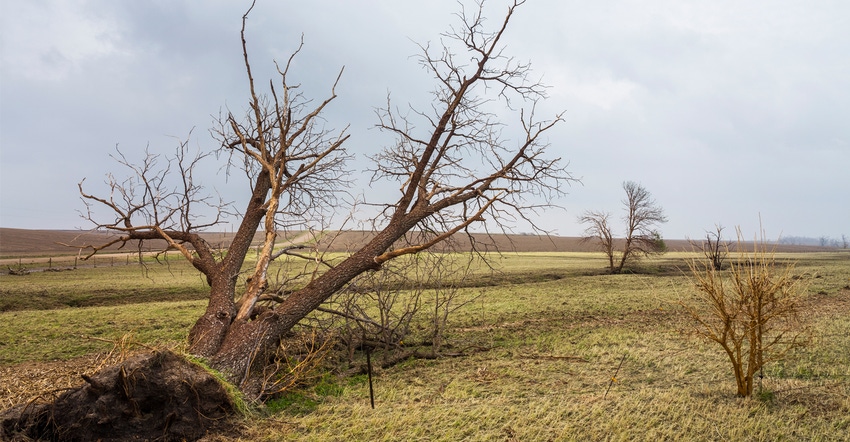
Extreme weather has been a part of Great Plains summers for centuries. Some summers are worse than others, producing large hail, damaging winds, tornadoes — and destruction to crops, livestock, farmsteads, farm homes and trees around the farm.
Crops, livestock, farm homes and barns are probably highest on your priority list after a big hailstorm, but trees around the farm can take a beating as well. This year, the Great Plains has seen its fair share of large and damaging hail, and it has pounded trees, young and old.
Farmer reports suggest that young trees, even those heavily damaged on the sides, with needles and leaves gone, eventually begin to push out new growth after a hail event.
What happens to a tree after a hail event could depend largely on how healthy the tree was to begin with. Mature, healthy trees are extremely resilient, and can generally survive even severe hail damage over time. They need to be cleaned up if there are broken limbs and torn bark, with much of the larger work best left to certified arborists.
These trees will also need to be monitored closely over the coming months, because storm-damaged trees are perfect harbors for insects and diseases that can further harm the tree.
Fighting chance
“Hail can damage leaves or completely defoliate a tree, wound the stem and trunk, and break twigs,” says Laurie Stepanek, Nebraska Forest Service forest health specialist. “Small trees may be killed. Hail wounds are typically elliptical in shape and occur on the upper branch surface, or on the side of prevailing winds on trunks and vertical branches.”
She notes that hail wounds also create openings through which pathogenic fungi can enter the tree and cause disease. “The damaged stems are easily infected, and extensive branch death beyond what the hail alone would have caused often develops weeks or months following the hail,” Stepanek says.
It takes patience. “Do not be too hasty to remove hail-damaged trees,” Stepanek says. “Trees defoliated by hail will frequently produce a new set of leaves. Damage to branches cannot be repaired, but the tree will try to produce a new wood that will cover over the hail wounds — a process that may take one or more years.”
A more accurate assessment of the damage is probably not made the day after the storm, but a year later.
What to do
The focus, Stepanek says, should be on providing a good root environment for the tree. “Check soil moisture and water only when necessary,” she advises. “A general guideline is if it does not rain, provide about 1 inch of water in clay soils or 2 inches in sandy soils per week. Apply water slowly to a large area around the tree, allowing the water to soak in. Water, at most, only once or twice per week. Automatic sprinklers that run every three or four days can kill trees.”
Mulching the tree with wood or bark chips at a depth of 2 to 3 inches also helps. “Do not pile the chips against the trunk,” Stepanek says. “The chips provide nutrients to the soil, conserve moisture and help limit competition from grass and weeds. Plus, the mulch keeps mowers and string trimmers away from the trunk.”
Landowners often want to fertilize the tree, but is that a good idea? “Nitrogen is important, but overfertilizing can be harmful to trees, especially trees that have been damaged,” Stepanek says. “If the tree is in an area under a fertilizer program, such as many lawns receive, do not apply additional nitrogen. If the area has never been fertilized, a very light application of nitrogen may provide some benefit.”
Remove hazards
While the resilience of hail-damaged trees should not be underestimated, hazard trees, broken limbs and unhealthy trees that have been damaged by hail cannot be taken lightly. If the tree causes a serious health hazard or looks like it may cause property damage, it is always best to have the tree evaluated by a certified arborist to see if it can be cleaned up and could recover, or if it needs to be removed altogether.
The bottom line for prevention of tree loss to hail damage is to maintain healthy woodlands and trees around your farm and ranch to begin with, because when hail, winds and storms damage these trees, they are much more likely to have the ability to recover and thrive than trees that are already stressed from insect and disease pressure.
Learn more by contacting your local arborist or state forestry agency.
About the Author(s)
You May Also Like






